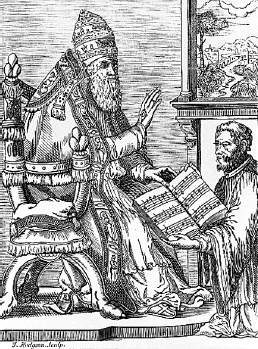Giovanni Pierluigi da Palestrina (c. 1525–1594), Pope Marcellus Mass (1557)
Palestrina was a singer in, or choirmaster of, many of Rome’s most famous churches and chapels, including the Sistine (Papal) Chapel. He lived in the repressive atmosphere of the Counter-

Because singing is so powerful a force in religion, as we noted on page 44, societies have felt a need to control it carefully. Christianity has witnessed periodic reforms to prune church services of musical features that came to be seen as extravagant. The Counter-
Gloria A section from the Gloria of the Pope Marcellus Mass, the “Qui tollis,” shows how the High Renaissance a cappella style changed after the time of Josquin. Compared with Josquin’s setting of these same words in his Pange lingua Mass (see page 65), Palestrina’s setting employs much more homophony. Apart from some fuzziness on a few individual words, only the last and longest line of Palestrina’s composition uses polyphony; this contrast makes for a fine climax.
Beyond this, we notice at once that vocal sonority is of major importance in Palestrina’s setting. He uses a larger and richer choir than Josquin — six vocal parts, rather than four — and keeps alternating between one and another subgroup, or semichoir, drawn from the total choir. Thus the first phrase, in high voices, is answered by the second, in low voices, and so on. The whole choir does not sing all together until the word suscipe.
What matters most to Palestrina are the rich, shifting tone colors and harmonies, which he uses to produce a generalized spiritual aura, sometimes ethereal, sometimes ecstatic. And with the aims of the Counter-
LISTEN
Palestrina, Pope Marcellus Mass, from the Gloria
|
Capital letters indicate phrases sung in homophony. |
||
| 0:00 | QUI TOLLIS PECCATA MUNDI, MISERERE NOBIS. | You who take away the sins of the world, have mercy upon us. |
| QUI TOLLIS PECCATA MUNDI, Suscipe DEPRECATIONEM NOSTRAM. | You who take away the sins of the world, hear our prayer. | |
| 1:23 | QUI SEDES AD DEXTERAM PATRIS, MISERERE NOBIS. | You who sit at the right hand of the Father, have mercy upon us. |
| 2:00 | QUONIAM TU SOLUS SANCTUS, TU SOLUS DOMINUS, TU SOLUS ALTISSIMUS, JESU CHRISTE, | For you alone are holy, you alone are the Lord, you alone are the most high, Jesus Christ, |
| 2:36 | CUM SANCTO SPIRITU, IN GLORIA DEI PATRIS. | With the Holy Spirit, in the glory of God the Father. |
| Amen. | Amen. | |